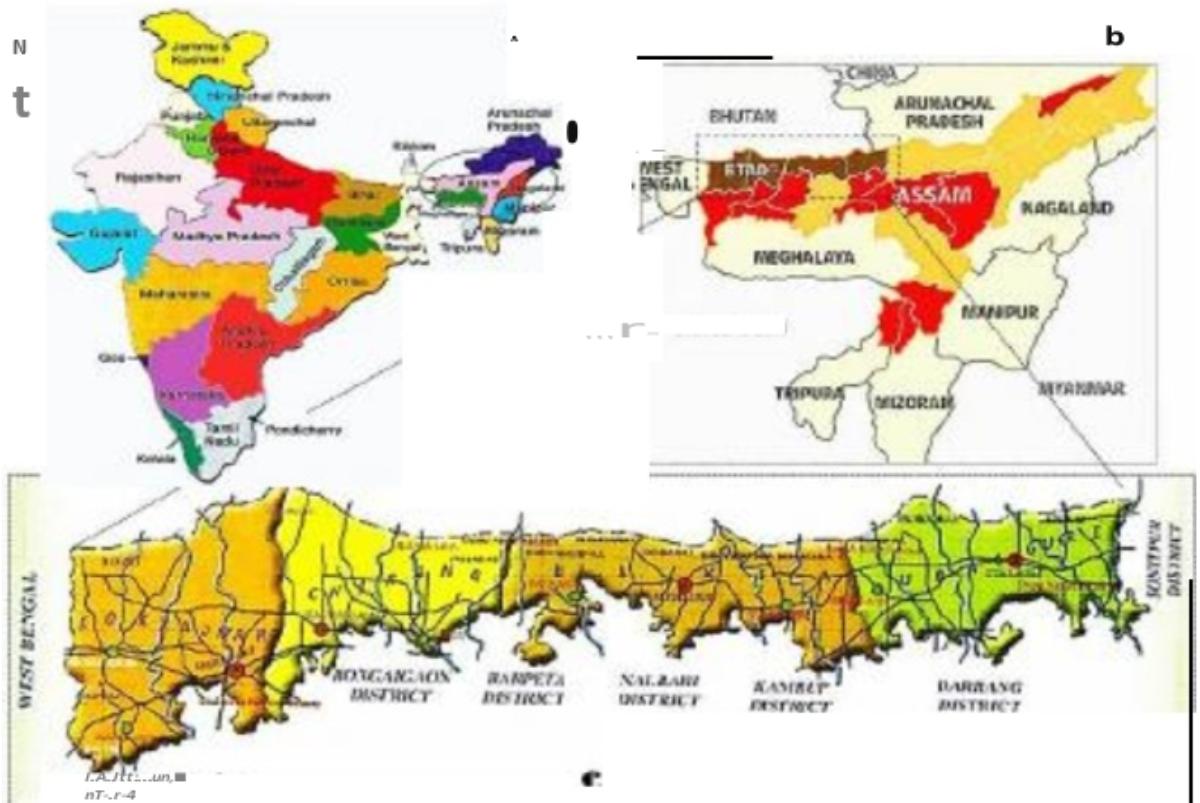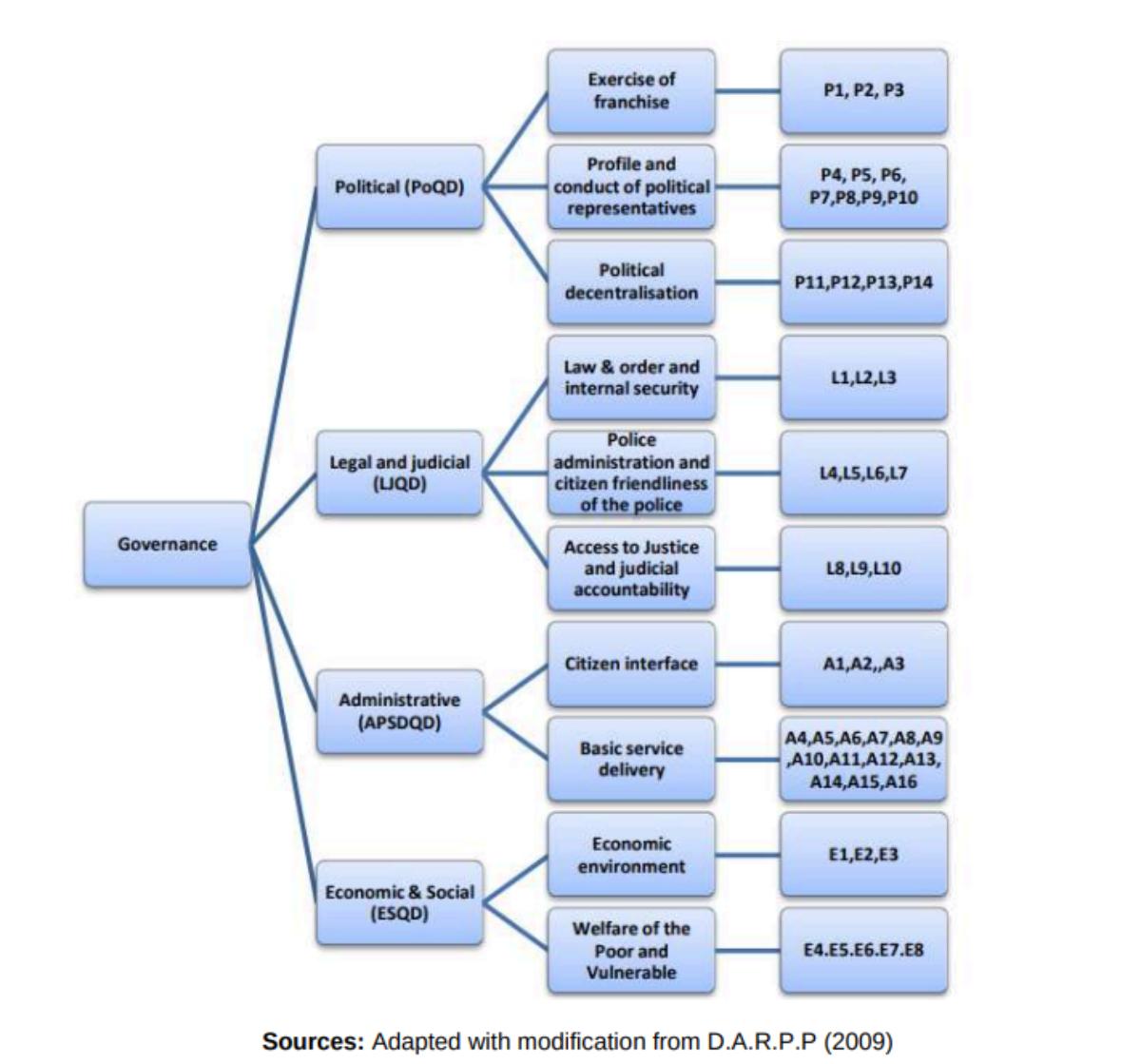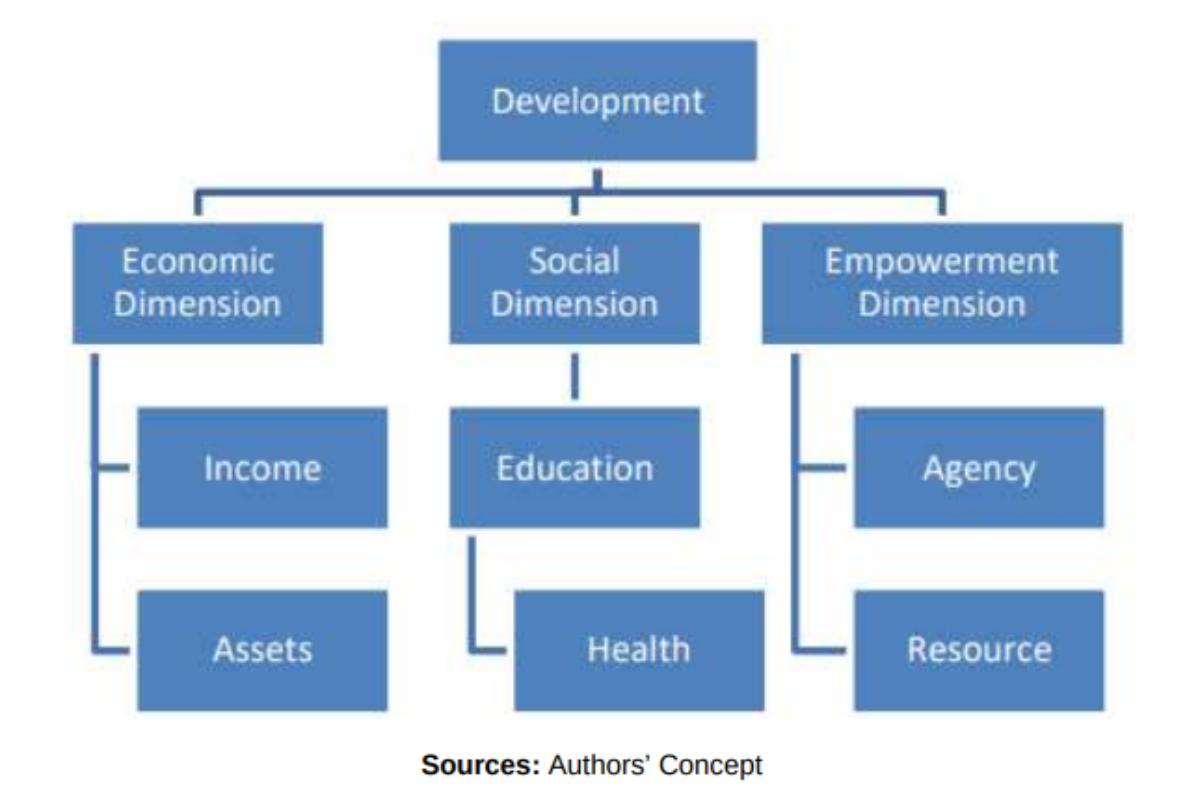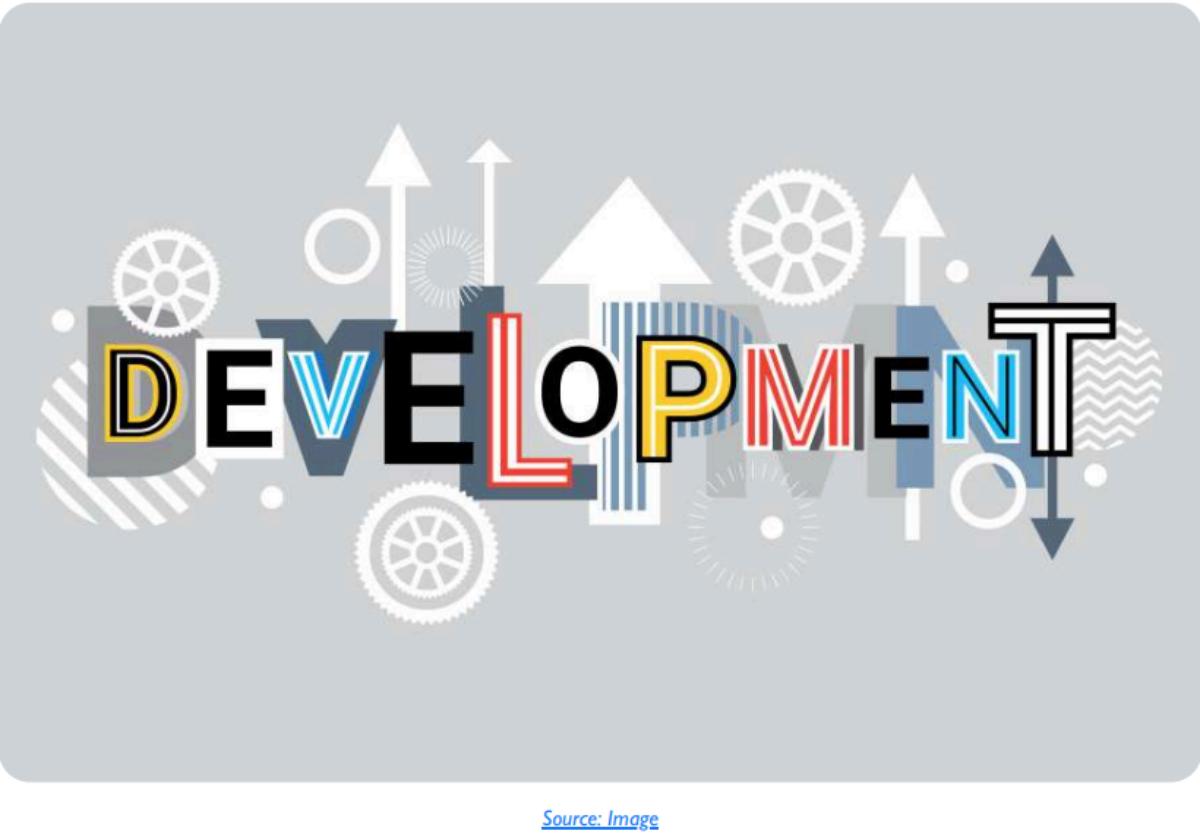Introduction
In developing economies, despite the potentials for accelerating economic development, there are various social, economic, institutional and geographical issues that inhibit enabling growth and development. The quality of instih1tions matters for economic development (Rodrick et al. 2004). The failure to factor in institutions as constraints/drivers of growth and development in developing countries during the 1980s has given rise to ‘development disorder’.
Governance as an institution has come out to be one of the most pressing challenges in the entire debate of economic development syndrome today. Contemporary discourses on development put issues of “governance” at the hea11 of an understanding of development as such poor countries are considered poor because their governance quality is bad, and rich countries are those that have better governance quality (Besley and Persson. 2011). Those poorly governed countries do not reap the benefits of public spending on various public sectors such as health and education (Rajk-lunar and Swaroop. 2008). It has been established that good governance may either directly or indirectly impact evaluations of well being of individuals.
According to (HelliwelL 2014) direct impact maybe, because people are happier living in a context of good government, and/ indirect maybe, because good governance enables people to achieve higher levels of something else that are associated to their well-being. In Development as Freedom, Sen (2000) sees development as expanding real freedoms such as escaping morbidity, being nourished, being literate and being able to participate in social function, etc. The means to these developmental outcomes depend on the nature and state of governance such as provisioning of public services, maintaining law and order and pa1ticipation of citizens in democratic franchising.
Economists agree that governance is one of the critical factors explaining the divergence in economic performance across developing countries (Khan. 2008). It has been agreed that in developing countries political com1ption and poor governance inhibit economic development and social battement (Kurtz. 2007). A bett.er level of governance has its impact on improvements in infrastructure, productive activities, health and education facilities and reduction of conniption (Mauro. 1995: Grindle. 2004; Banerjee and Iyer. 2005). There is also empirical evidence with respect to the access of citizens to governance mechanisms linked with development performance, discriminato1y governance mechanisms leading to poor development, links between democratic governance, distribution, and standards of living (Oster. 2009; Kumar. 2013; Blaydes and Kayser. 201I).
Corruption also significantly affects the well being of individuals in society. According to a cross-country European study, Tavits (2008) fom1d that when the level of com1ption is higher, people tend to repo1t lower levels of subjective well-being. Similarly a study by Heukamp and Arii10 (2011) in a sample of 64 countries shows lower levels of con1.1ption in a country significantly increases life satisfaction, even when taki11g i11to account many other related variables. Cheung and Leung (2007) found a significant positive correlation between perceived government accountability and life satisfaction, especially for those with less social power in China. Rodriguez-Pose and Maslaukaite (2011) show that the greater is the level of political decentralization the greater is the degree of life satisfaction. Similarly, Ott (2011) finds that good governance lowers inequality of happiness among citizens. A study in South Africa reveals that “improvements to local services were closely associated with increases in happiness among all sectors of the population, includi11g rural dwellers and the poor” (Moller and Jackson, 1997). Lou (2009) observed that Chinese citizens were more likely to report a high level of personal well-being when government policies are responsive to their needs, and studies also show that Government effectiveness is positively associated with life satisfaction (Fereidouni, Najdi, and Amiri, 2013; Kim and Kim_ 2011).
Map of Study Area (BTAD)

Thus, many studies have empirically examined the relationship between different aspects of governance and economic development and well being at different points of time and space. What becomes evident therefore is that governance matters for economic and social development. Hence, it is a vital area of research that needs to be tested across time and space for developing appropriate policies. In this study, we attempt to examine the relationship between the quality of governance and level of development the Bodoland Territorial Area District (BTAD) of Assam in North East India. Thus, we developed the following research questions and hypothesis.
Research Questions
What is the relationship between the level of development and quality of governance in BTAD?
Which dimensions of governance influence the level of development?
Hypothesis H1: Level of development is associated with the quality of governance
The significance of the present study lies in its setup whereby BTAD is an underdeveloped area in terms of various social and economic development indicators. Bodoland Territorial Area District (BTAD) falls within the jurisdiction of the Bodoland Territorial Council (BTC). BTC is an autonomous territory within the state of Assam in India, which was created on 10th February 2003 through Memorandum of Understanding (MoU) between the Union government of India, State Government of Assam and the then militant group Bodo Liberation Tiger Force (BLTF). BTC was created in order to provide “constitutional protection under Sixth Schedule to the said autonomous body; to fulfill economic, educational and linguistic aspirations and the preservation of land-rights, socio-cultural and ethnic identity of the Bodos; and speed up the infrastructure development in BTC area” (Bodoland Territorial Council Accord 2003). Since its inception, fifteen years have passed whereby these mentioned developmental activities have been undertaken by the government and its associated institutions in BTAD. It is in this context; we attempt to examine the relationship between the level of development and quality of governance in BTAD. We also assess which dimensions of governance influence the level of development. In the pursuit of this exercise, we develop a framework for the analysis of quality of governance and development and their interrelationship. The study is based on data reported by the citizen’s cognitive evaluations of the extent to which they perceived governance from their experiences and their achievements in various developmental parameters.
The Unfolding Concept and Practice of Governance
The elements of good governance and their relation to development have been reflected in a plethora of works undertaken by a number of multilateral organizations like the United Nations Development Programme and the World Bank amongst others. According to the World Bank (1992). governance is defined “as the manner in which power is exercised in the management of a country’s economic and social resources”. Similarly, UNDP (1997) defines governance as the “exercise of economic, political and administrative authority to manage a country’s affairs at all levels which comprises mechanisms, processes, and institutions, through which citizens and groups articulate their interests, exercise their legal rights, meet their obligations and mediate their differences”. These broad dimensions of governance of the two international bodies have become popular and are used by many researchers and institutions to study various aspects of governance and its relation to developmental outcomes.
In the context of India the term ‘governance’ gained currency during the liberalization of the Indian economy in the 1990s (Mathur, 2015). Subsequently, the Tenth plan (2002-2007) in India made explicit mention of the term governance whereby it was stated that “governance has in the recent times merged at the forefront of the development agenda and good governance is one of the most crucial factors required if the targets of the Tenth Plan are to be achieved”. According to the Tenth Plan, Governance relates to “the management of all such processes that, in any society, define the environment which permits and enables individuals to raise their capability levels, on one hand, and provide opportunities to realize their potential and enlarge the set of available choices, on the other”.
Notably, there are few institutions and scholars in India who attempted to evaluate governance on the basis of some dimensions. Mathew et al. (2017) identified 10 themes encompassing 25 focus subjects spread over 68 indicators in order to develop a Public Affairs Index (PAl) for the Indian states. The main components of good governance included in the index are the rule of law, benign policy environment fostering a market for growth, public services, social sector responsibility, accountability, information, etc. Mundel et al. (2016) in their study used the output of the quality of public service delivery as the measure of the quality of governance in Indian states and prepared an index of governance quality to rank states of India. Virmani et al. (2006) also computed an index of quality of governance at the state level in terms of the provision of public goods by the state governments in India and also in Pakistan and Sri Lanka. Similar studies on governance were undertaken by Court (2003) and Basu (2002).
On the basis of the above discussion, in our study governance has been analyzed in a multidimensional framework and is defined as “the way economic, political and administrative authority” is exercised for the development of BTAD. This implies the performance of various institutions within the territory which enables individuals to raise their capability levels and provide opportunities to improve their socio-economic condition. In this study, important dimensions pertaining to measuring the quality of governance is a broad manifestation in several institutions such as Political, Legal and Judicial, Administration and Public service delivery, and Economic and Social.

The Framework of Governance Assessment
The empirical approach to the study of the quality of governance at the local level needs to consider the economic and social setting of the study area. In this context, we have adopted the framework of governance assessment from the Department of Administrative Reforms, Public Grievances and Pensions (DARPP 2009) which was developed keeping intact the Indian political economy context. This framework encompasses and is incongruent with the principles and constituents of the quality of governance of the World Bank and UNDP, thus making it a globally competent one. However, we have modified the framework according to the suitability and need of our study thus contextualizing the approach. There are four dimensions of governance pertaining to measuring Quality of Governance (QoG) that have been used in this study namely: Political (PoQD), Legal and Judicial (LJQD), Administrative and Public Service Delivery (APSDQD) and Economic and Social dimensions (ESQD). Each of these dimensions has been captured by several other attributes of governance. These dimensions of the quality of governance (QoG) has been discussed in the following and depicted in figure 1.
Political Quality Dimension: Political Quality Dimension (PoQD) assesses the perceptions of the people in matters of conduct of individuals and institutions representing the people, contestation and use & abuse of political authority, decentralization and citizen’s faith in the political system. This component has been captured by the questions: whether they have voted in the last council election, whether there were any incentives offered by any political parties in cash/kind or whether the election was held in a peaceful environment. Another political dimension of governance pertains to asking the public about the accessibility to the elected leaders, their transparency and accountability, arid the performance/functioning of the Village Council Development Committee (VCDC), Tow11 council/Municipalities.
Legal & Judicial Quality Dimension: The state is vested with coercive power to maintain law and order the state must ensure that every individual has the right to justice. This function of the state has vital implication for economic activity that when the general law and order is seen to be poor; investors, businesses, etc. are affected, which has detrimental effects on the economic environment and employment opportunities of the people. Under the Legal and Judicial Quality dimension (LJQD), we seek to assess prevailing law and order wherein citizens’ lives and property are generally safe and secure. This component has been captured by asking the questions related to trust in the police/judiciary and other security measures served by the administration.
Administrative and Public Service Delivery: Provision of public services is the most important function of the state. The citizens of a country, especially the poor and disadvantaged, depend on the government for various public services such as basic infrastructure, education, primary healthcare, water, arid sanitation, etc. For the majority of the population, this reflects governance – good or otherwise. The Administrative and Public Service Delivery Quality Dimension (APSDQD) is caph1red by asking the respondents about their accessibility to the public services, the nature of the response to the needs of the general public and their grievances, perceptional level of corruption, etc.
Economic and Social Dimension: The Economic and Social Quality Dimension (ESQD) looks at the ability of the state to cater to the needs of the poor sections of the society and to create a conducive environment for economic activity to take place. This component pertains to those aspects of economic governance which affect the livelihood of the people within the territory and includes general investment climate, credit facility, infrastructure, etc. This component has been captured by asking the respondents whether they avail benefits of social security schemes such as monthly ration, housing, etc. And also, respondents were asked about their treatment in public places due to being different in religion, caste/community, etc.
Figure 1: Framework of Governance Quality Analysis

The framework of governance analysis as depicted in figure 1 is the basis of our study. Governance constitutes four dimensions namely Political (PoQD), Legal and Judicial (LJQD), Administrative and Public Service Delivery (APSDQD) and Economic and Social dimensions (ESQD); and these dimensions have been captured by forty-eight indicators. The last branch in figure 1 (i.e. Pl, P2, P3, … , E6, E7, E6) depicts the indicators that have been used in the questionnaire to draw the data.
Contextualization of Development

Economic development implies an improvement in the standard of living and well being. According to Sen (1988) in order to assess “what kind of a life the person has succeeded in living, we have to take a more integral view of that person’s life apart from the real income enjoyed by a person in a given year, which otherwise reflects at best only the extent of well being enjoyed by that person at that period of time”. Hence we posit that broader evaluation of the level of development of individual/society has to be undertaken in a multidimensional framework and should include economic status, social status, and empowerment. A household/individual may be economically poor but maybe rich in other dimensions of social status and empowerment and vice versa.
The present study considers three dimensions of development viz. economic, social and empowerment for evaluation of a household/societal level of development that has been discussed in the following.
Economic: This dimension assesses the economic status of the household. There are different ways to assess the economic condition of a household; one very fundamental indicator that has been rigorously used in economic analysis is the income. However, with the genesis of various dimensions of development, income has been considered only as a means to end; hence we include two components of economic status in this study namely: income and assets. Assets in this study include durable goods such as Television, Mobile Phones, Motor vehicle, Bi-cycle, etc. and household characteristics such as type of floor, roof, presence of drinking water facilities, separate kitchen, toilet, etc.
Shariff (2017) in his analysis of district development for some Indian states constructed the ‘composite district development index’ using both income and assets as measures of economic stah1s and material wellbeing respectively. Income variable and asset measure may be correlated; however, the two might reflect different dimensions of economic well being (Gasparini et aL 2008; Lora. 2008; Headey and Wooden. 2004; D’Ambrosio et al., 2009). Income reflects the sho1t nm wealth and long-nm wealth can be derived by nonmonetary assets which give an understanding of the long-run financial conditions of individuals and households (Kuypers. 2018). In a primary study as this one, it appears that sometimes a household may be poor in terms of monetary income but when we consider household assets including livestock, land, carts, television, etc., it balances out m comparison with those counterparts who are rich monetarily. Therefore, overlooking wealth in terms of assets apart from the direct income flows misses much of the scope for analysis of the level of development.
Social: Social dimension of development analysis has been captured by the health and educational status in empirical studies by researchers and institutions such as in UNDP Human Development Index (HDI), Sustainable Society Index (SSI), and Composite Global Well-Being Index (CGWBI) among others. In this study also, we use educational achievement and health status in the analysis of social development. According to Diener et al. (1997) development must be able to make an individual healthy and knowledgeable.
Empowerment: This dimension is another very important part of the analysis of development; an individual who claims to be developed, /he must be empowered too. However, it is a complex dimension to deal with and not everyone accepts that empowerment can be clearly defined, let alone measured (Kabeer, 1999). In this study, empowerment is analyzed from the perspective of women empowerment. The inclusion of women empowerment in development analysis is significant in India for the well-being of the entire household (Kishor and Gupta, 2004). We ascribe to the empowerment domains of resources and agency space (Mahmud and Tasneem, 2014) in evaluating the status of women empowerment in this study.
Being able to make independent decisions with respect to political participation, social practices (religion, festival) ai1d marriage, etc. are important indicators of empowerment (Charmes and Wieringa, 2003). The empowerment aspect of the developmental analysis is what Sen (1985) terms as capabilities: the potential that people have for living the lives they want. In the field investigation, questions related to empowerment were asked within the domains of resource (economic), agency (socio-cultural), and agency (interpersonal). These dimensions deal with the decision making and power of the women in their personal decision and household functioning.
Based on the above discussions, our evaluation of development is based on the framework as depicted in figure 2. It constitutes three dimensions of development namely economic, social and empowerment. Under “economic dimension”, income and assets have been used as the indicator; under “social dimension” education and health are used as the indicator and empowerment dimension has been captured by the domains of agency and resource.
Data and Methodology
Bodoland Territorial Area District (BTAD) which is the study site is situated on the lower Assam within India’s North Eastern Region (Figure 3) It comprises of four districts (Kokrajhar, Chirang, Baksha, and Udalguri) and has a population of about 3,155,359 (in lakh) and an area 8,821.68 sq.km (Census 2011). In this study, we have purposively selected two districts of BTAD, namely Kokrajhar and Udalguri. We selected six Community Development Blocks (CDB) from each district and from the selected CDBs, 17 villages were sampled to collect data at the household level. Households were randomly selected from the sample villages and from each household, an adult member above 18 years was randomly chosen as the respondent. The present study used data from the field survey of 400 households in both rural and urban areas of the two districts. The method used to collect the data was direct personal investigation through a scheduled
Figure 2: Framework of Development Analysis

Sources: Authors’ Concept
questionnaire which is given in the appendix. A field survey was conducted by the author from February to May 2018.
Construction of Indices: Our analysis is based on the index value of governance and development variables. We have constructed Composite Quality of Governance Index (QoGI) on the basis of four sub-indices of governance namely: Political Quality Dimension (PoQD), Legal and judicial (LJQD), Administrative (APSDQD) and Economic & Social (ESQD). Similarly, for the development variable, we have constructed Composite Development Index (CDI) on the basis of three sub-indices of development namely: Economic Index (Eel), Social Index (Sol) and Empowerment Index (EmpI).
In order to obtain the Composite Development Index (CoDI) and the Quality of Governance Index (QoGI), we follow the following steps:
Step 1: The values in each indicator of a sub-dimension have been summed up to get the Sub-dimensional Score.
Step 2: Having derived the dimensional score, we have standardized the values by the following method:
Where, X;j istl1e standardized score ofj sub-dimensions and i households, i=I,2,3,..,400
Step 3: Standardised Dimensional score obtained have been used to obtain the value of the dimensional index by the following equation:
Where Cij is one of the components of governance/development dimensions; index Xij is the subcomponent that constitutes the main component (Cij) and n is the number of sub-components.
Step 4: Having obtained the Dimensional index (Cij), the next step is weighting. We have used the method of Principal Component Analysis to derive the weights for each dimension.
We computed the weighted dimensional index as follows:
Where, Zij is the weighted dimensional score of j dimension; is the weight of j dimension and X;j is the actual score of the dimension, where i =1,2,3, ,400
Step 5: Finally, the Composite Indexes obtained by taking the average of the Zij i.e.
Where, Y; is the Composite Index (QoGI or CoDI); i=l,2,3,…,400 and N= total number of dimensions.
The value of the composite index lies between 0 and 1. The value closer to 1 shows a higher level of development/better governance and value closer to 0 represents a poor level of development/governance.
Results and Discussion
Correlation Analysis: Pair-wise Spearman correlation analysis indicates the existence of important relationships between variables of governance and development (see Table 1). The correlation results between the level of development (CoDI) and Quality of governance (QoG) in BTAD is found to be positive and significant (p<.05). This implies that improvements in economic and social development and empowerment are related to the quality of governance.
When we examine the correlation across dimensions of QoGI and CoDI, we find that CoDI& LJQD and QoGI& Empowerment do not have significant relationship. Nevertheless, the positive correlation between these dimensions of development and governance is indicative of the fact that improvements in LJQD and QoGI will have a positive impact on the CoDI and Empowerment respectively.
However, a very significant relationship (0.01 level) is observed between the CoDI and APSD which is suggestive of the fact that as administrative and public service delivery dimensions of governance improve, there will also be improvement in the level of development. Similarly, we find that CoDI and Political dimensions of governance (PoQD) are correlated at 0.05 level of significance. We also find that QoGI is significantly associated with economic and social development dimensions.
Despite the results of positive and significant correlations of the considered variables of development and governance in the BTAD as a whole, when we examine it district ·wise sharp differences were observed in the direction of the relationship between QoGI and CoDI and their components. This depicts the regional disparity in the study area and therefore uniform developmental policy framework is envisaged for balanced spatial development.
The result shows that in Udalguri there is a negative relationship between CoDI & QoGI, CoDI & LJQD, CoDI & APSD, and QoGI & Empowerment. The positive relationship is observed only in the case of CoDI & PQDI, QoGI & Economic and QoGI & Social; although the relationship is not statistically significant. This result, however, is not surprising… Having visited the places in Udalgmi during our field survey, we observed that people’s perception of governance and development about their locality as compared to Kokrajhar is poor. The infrastructural facilities such as roads and bridges and other social services such as educational facilities are perceived to be poor and opined that all the developmental works have been driven towards Kokrajhar.
It is fair to say that the majority of the developmental works under BTAD have been undertaken in Kokrajhar district until recent years. For instance, apm1 from other infrastructural development, prominent ones are in the educational sectors such as the establishment of ITI, Bodoland University, Central Institute of Technology (CIT), Bineswar Brahma Engineering College, Medical College, etc. This perception of being deprived of developmental facilities might be a reason for the negative correlation in Udalguri. However, in Kokrajhar district, there exists a positive correlation across all dimensions of governance and development and the relationship is statistically significant at p<0.01 in the case of CoDI & QoGI, CoDI & APSD, QoGI & Empowerment. On the other side, the QoGI & Economic dimension of development has a positive significant relationship at p<.05. Although the relationship between CoDI & LJQD and QoG I& Social is positive, it is not statistically significant.
Table 1: Rank Conelation between CoDI and QoGI, CoDI and dimensions ofQoGI
| Study | N | CoDI | CoDI | CoDI | CoDI | CoDI | QoGI | QoGI | QoGI | ||
| Area | QoGI | PQDI | LJQ | APS | ESD | Economic | Social | Empowerment | |||
| D | D | ||||||||||
| Kokrajhar | 210 | .222** | .113 | .114 | .223** | .134 | .154* | .113 | .241** | ||
| Udalguri | 190 | -.015 | .088 | -.022 | -.023 | -.103 | .004 | .102 | -.088 | ||
| BTAD | 400 | .121* | .106* | .050 | .130** | .035 | .099* | .114·* | .092 |
** denotes significance of correlation at the 0.01 level, * denotes at the 0.05 level







